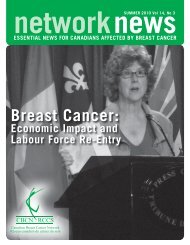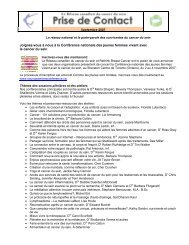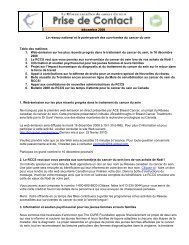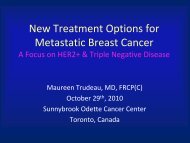Network News - Winter/Spring 2010 - Canadian Breast Cancer ...
Network News - Winter/Spring 2010 - Canadian Breast Cancer ...
Network News - Winter/Spring 2010 - Canadian Breast Cancer ...
Create successful ePaper yourself
Turn your PDF publications into a flip-book with our unique Google optimized e-Paper software.
Defining BRCA Genes<br />
By Kelly Metcalfe, RN, PhD<br />
In 1994 and 1995 respectively, the<br />
BRCA1 and BRCA2 genes were<br />
discovered. For women who carry<br />
a mutation in one of these genes, the<br />
risk of developing breast cancer is<br />
estimated to be up to 87% by the age of<br />
70 1 . Women with a BRCA1 or BRCA2<br />
mutation have one of the highest known<br />
risks for the development of breast<br />
cancer. However, with this genetic<br />
information, women are in a position to<br />
be able to reduce their breast cancer risk<br />
by using breast cancer risk prevention<br />
strategies. Therefore, the value of<br />
genetic testing for BRCA1 and BRCA2<br />
mutations is that high-risk women can<br />
be identified, and ultimately fewer<br />
women will be diagnosed with breast<br />
cancer and die of the disease. However,<br />
this is all dependent on whether or<br />
not a woman elects for a breast cancer<br />
prevention option.<br />
The current cancer reduction<br />
options available to women with<br />
a BRCA1 or BRCA2 mutation<br />
are chemoprevention (including<br />
Tamoxifen) 2 3 , or prophylactic surgery<br />
(mastectomy and oophorectomy) 4 5 .<br />
None of these options offer women<br />
a 100% breast cancer risk reduction,<br />
and each preventive option has<br />
risks and benefits, both medical and<br />
psychological. These circumstances<br />
cause the decision-making process to<br />
be difficult for women regarding breast<br />
cancer prevention.<br />
A prophylactic mastectomy involves<br />
the removal of both breasts in the<br />
absence of disease. The goal of<br />
prophylactic mastectomy is to prevent<br />
breast cancer, with its potential for<br />
metastatic spread and potential to<br />
cause death. Studies by Hartmann<br />
et al. suggested that prophylactic<br />
mastectomy offers a reduction in<br />
risk of breast cancer of 80% or more<br />
in women with a family history of<br />
breast cancer 6 , and greater than an<br />
89% risk reduction in women with a<br />
known BRCA1 or BRCA2 mutation 4 .<br />
Meijers-Heijboer et al. also found<br />
that there was a significant risk<br />
reduction of breast cancer associated<br />
with prophylactic mastectomy when<br />
compared to women undergoing breast<br />
screening 5 . Research suggests that<br />
satisfaction with the decision to have<br />
prophylactic mastectomy is high 7 8 , and<br />
that psychosocial functioning is not<br />
compromised 7 9 .<br />
In addition to an increased risk of<br />
breast cancer, women with a BRCA1<br />
or BRCA2 mutation also have an<br />
increased risk of developing ovarian<br />
cancer. The preventive removal<br />
of the ovaries and fallopian tubes<br />
(prophylactic oophorectomy) can<br />
provide significant reductions in risk<br />
of both breast and ovarian cancers<br />
in women with a BRCA1 or BRCA2<br />
mutation. Estimates of the effectiveness<br />
of prophylactic oophorectomy in<br />
preventing ovarian cancer have<br />
varied widely from 60% to 95% 10-12 .<br />
Prophylactic oophorectomy has also<br />
been shown to reduce the risk of breast<br />
cancer in women with a BRCA1 or<br />
BRCA2 mutation. The greatest risk<br />
reduction is observed if a woman has<br />
a prophylactic oophorectomy prior to<br />
the age of 40 (50% breast cancer risk<br />
reduction) 13 . After the age of 50, no<br />
benefit in breast cancer risk reduction<br />
is observed. Overall, prophylactic<br />
oophorectomy is effective at reducing<br />
the risk of both breast and ovarian<br />
cancers in women with a BRCA1 or<br />
BRCA2 mutation. However, there<br />
are important side-effects (eg. hot<br />
flashes, vaginal dryness, decreased<br />
libido) associated with this surgery,<br />
as a woman is placed into immediate<br />
menopause.<br />
Tamoxifen is a medication that is<br />
taken to reduce the risk of developing<br />
breast cancer. It is a selective estrogen<br />
receptor modulator (SERM) that<br />
competes with estrogen for binding<br />
to the estrogen receptor. In humans,<br />
Dr. Kelly Metcalfe<br />
Tamoxifen acts as an estrogen<br />
antagonist in breast tissue, inhibiting<br />
the growth of estrogen-dependent<br />
breast tumors 14 . Among high-risk<br />
women, a 49% risk reduction of<br />
invasive breast cancer risk has<br />
been associated with Tamoxifen 15 .<br />
Tamoxifen usage has been shown<br />
to reduce the risk of invasive breast<br />
cancer by 62% in healthy BRCA2<br />
carriers 2 . In addition, Tamoxifen<br />
has been shown to be effective at<br />
preventing contralateral breast cancer<br />
(breast cancer in the opposite breast)<br />
in both BRCA1 and BRCA2 mutation<br />
carriers with breast cancer 3 16 . In the<br />
National Surgical Adjuvant <strong>Breast</strong> and<br />
Bowel Project (NSABP) P-1 Study 15 ,<br />
which examined breast cancer risk<br />
reduction associated with Tamoxifen<br />
use in high-risk women, there were<br />
medical side-effects associated with<br />
Tamoxifen including endometrial<br />
cancer, vascular events, and cataracts.<br />
Making decisions about breast cancer<br />
prevention are difficult for women.<br />
Each option that is available to them<br />
has benefits and risks (both medical<br />
and psychological). No choice will<br />
satisfy every one of an individual’s<br />
personal objectives and no alternative<br />
is without its risk of undesirable<br />
outcomes. To try to help women with<br />
these difficult decisions, we have<br />
recently developed a decision aid for<br />
breast cancer prevention in women<br />
with a BRCA1 or BRCA2 mutation.<br />
The decision aid was developed to<br />
provide decision support to women<br />
with a BRCA1 or BRCA2 mutation<br />
regarding breast cancer prevention. We<br />
are currently testing the decision aid<br />
to determine if it is helpful for women<br />
who have recently learned that they<br />
6 <strong>Network</strong> <strong>News</strong> <strong>Winter</strong>/<strong>Spring</strong> <strong>2010</strong>














